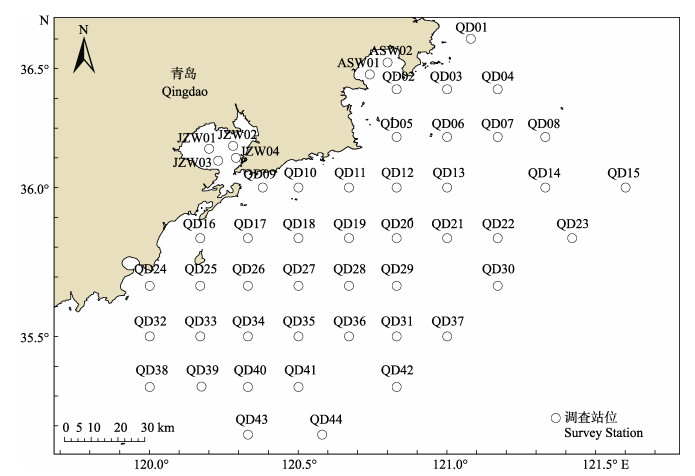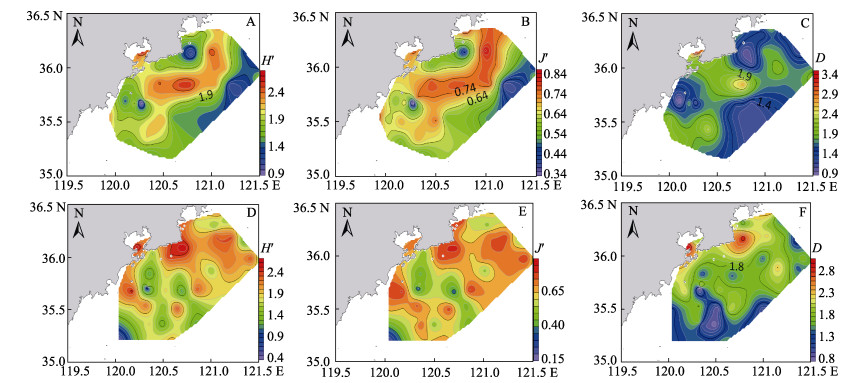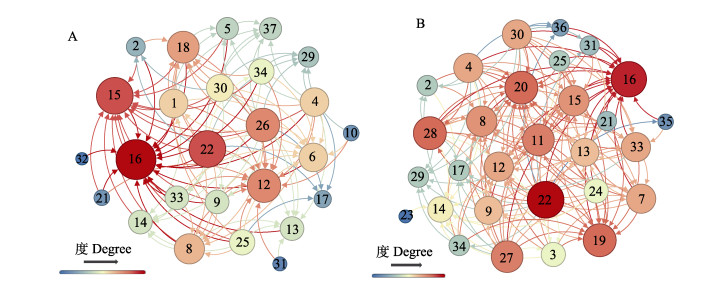2. 中国水产科学研究院黄海水产研究所 农业农村部海洋渔业与可持续发展重点实验室 山东 青岛 266071;
3. 山东长岛近海渔业资源国家野外科学观测研究站 山东 烟台 265800
 (Lophius litulon)和戴氏赤虾,食物网结构相对稳定。夏、冬两季青岛近岸海域渔业生物群落表现出较强的抗扰动能力。
(Lophius litulon)和戴氏赤虾,食物网结构相对稳定。夏、冬两季青岛近岸海域渔业生物群落表现出较强的抗扰动能力。2. Key Laboratory of Marine Fisheries and Sustainable Development, Ministry of Agriculture and Rural Affairs, Yellow Sea Fisheries Research Institute, Chinese Academy of Fishery Sciences, Qingdao 266071, China;
3. National Field Observation and Research Center for Fisheries in Changdao Waters, Yantai 265800, China
青岛近岸海域包括鳌山湾、胶州湾、灵山湾等多个海湾,是多种渔业生物的产卵场、索饵场和渔场(陈大刚, 1991; 刘效舜等, 1990)。2021年,青岛市渔业生产总值为225亿元,占山东省渔业生产总值的13.6% (山东省统计局, 2022)。近年来,受人类活动的影响,青岛近岸海域环境渐趋恶化,生态系统功能退化,生物多样性降低,特别是夏季绿潮、水母等生态灾害频发,对渔业资源补充和可持续产出造成严重威胁(曲同飞等, 2020);渔业资源呈低龄化、小型化、低值化,小黄鱼(Larimichthys polyactis)和蓝点马鲛(Scomberomorus niphonius)等传统经济鱼类资源衰退(唐启升等, 1990; 张波等, 2004; 金显仕等, 2005; Jin et al, 2013)。
目前,针对青岛近岸海域渔业生物群落结构特征的研究多集中于春、秋季(任一平等, 2005; 徐宾铎等, 2007),鲜有夏、冬季的相关数据。夏季是渔业生物快速生长的关键阶段,既与春季新生群体的索饵密切相关,又决定了秋季渔业资源生物量和来年资源补充量;冬季渔业资源结构特征则反映了捕捞过后剩余群体情况,这决定了第二年春季产卵群体的数量。本研究基于夏、冬两季青岛近岸海域渔业资源调查数据,分析渔业种类组成、群落结构和多样性,构建食物网拓扑结构,分析其关键种变化及其生态位,以期为该海域渔业资源养护与管理提供科学依据。
1 材料与方法 1.1 数据来源本研究基于2022年7月22日―8月3日及2022年11月24日―12月7日在青岛近岸海域机轮拖网禁渔线以内水域(35°10′~36°30′N;119°50′~121°36′E)的渔业资源调查(图 1)。调查采用300马力单拖渔船,网具参数:网口宽度25 m,囊网网目20 mm;拖网时间为1 h,拖速2.0~3.0 kn。

|
图 1 青岛近岸海域采样站位 Fig.1 The sampling stations in the coastal waters of Qingdao |
现场记录拖网卡片,根据渔获量进行全部取样(< 20 kg)或随机抽样(> 20 kg),对取回样品进行分类并冰鲜保存,带回实验室进行生物学分析。将所有渔获物的重量和尾数标准化为拖网时间1 h、拖速3.0 kn的渔获数值,再进行数据分析。
1.3 研究方法 1.3.1 优势种渔业生物群落中优势种类根据Pinkas等(1971)提出的相对重要性指数(index of relative importance, IRI)确定:
| $ \operatorname{IRI}=(N+W) \times F \times 10^4 $ | (1) |
式中,N为某一种类的数量占总数量的百分率,W为某一种类的生物量占总生物量的百分率,F为某一种类出现的站数占调查总站数的百分率。
相对重要性指数(IRI)包含了个体数、生物量及出现频率3个重要信息,常被用来研究群落中各种类的生态优势度(苏程程等, 2021; 赵永松等, 2022)。本研究中,IRI值≥1 000定为优势种,IRI值在100~1 000之间为重要种,IRI值在10~100之间为常见种,IRI值< 10为少见种。
1.3.2 群落结构指数生物多样性指数计算公式:
香农–威纳(Shannon-Weaver)多样性指数(H′) (Shannon, 1948):
| $ H' = - \mathop \sum \limits_{i = 1}^s {P_i}\ln {P_i} $ | (2) |
均匀度指数(Pielou指数) (J′) (Pielou, 1975):
| $ J' = \frac{{H'}}{{\ln S}} $ | (3) |
Margalef种类丰富度指数(D)(Margalef, 1958):
| $ D=\frac{S-1}{\ln W} $ | (4) |
式中,Pi为第i种鱼占总渔获量的比值,S为样品中的种类总数,W为总渔获量。J′最大值为1,该值越大,种间个体数差别越小,反之则种间个体数差别越大。
种类更替率(E)采用2个季节间采集到物种的并集进行计算,公式为(金显仕等, 2005):
| $ E = \frac{A}{{A + B}} $ | (5) |
式中,A为季节间种类增加与减少数之和,B为两月共现种类数。
1.3.3 食物网拓扑结构较大个体渔获物采用胃含物分析并结合相关文献确定摄食关系,如白姑鱼(Pennahia argentata)、大泷六线鱼(Hexagrammos otakii),其余食性数据参考邓景耀等(1997)、杨纪明(2001)、薛莹(2005)、张学健等(2010)、贺舟挺等(2012)、杨涛(2016)、张波(2018)、徐从军等(2020)和赵永松(2022)。
食物网拓扑结构指数计算公式:
节点密度(density, Dd)(Dunne et al, 2002):
| $ D_{d }= S/L $ | (6) |
种间关联度指数(connectance, C)(Dunne et al, 2002):
| $ C = L/S^{2} $ | (7) |
式中,S为鱼类群落种类数量,L为群落内存在摄食关系的数量。Dd值越大,群落内物种摄食关系的平均值越大;C值越大,物种间存在捕食–被捕食的概率越大。
采用网络中心法指数,包括点度(degree, D)、入度(in-degree, Din)、出度(out-degree, Dout)、中间中心性(betweenness centrality, BC)、紧密中心性(closeness centrality, CC)、信息中心性(information centrality, IC)、拓扑重要性指数(topological importance index, TI)、关键性指数(keystone indices, K)、上行关键指数(bottom-up keystone index, Kb)、下行关键指数(top-down keystone, Kt)、群落离散度(fragmentation, F)和距离权重离散度(distance-weighted fragmentation, DF),群落种间聚类系数计算参照Watts等(1998)。
1.4 统计分析使用Ucinet 6软件计算D、Dout、Din、BC、CC和IC,使用CoSBiLab Graph 1.0软件计算TI1、TI7、K、Kb和Kt,使用Keyplayer 1.44软件计算F和DF,绘图使用ArcGIS 10.7软件和OriginPro 2022软件。
2 结果 2.1 种类组成及优势种夏季捕获渔业生物92种,其中,鱼类60种(中上层鱼11种,底层鱼49种)、虾蟹类23种(虾类10种,蟹类12种,虾蛄1种)、头足类9种。冬季捕获渔业生物86种,其中,鱼类55种(中上层鱼8种,底层鱼47种)、虾蟹类22种(虾类13种,蟹类8种,虾蛄1种)、头足类9种。夏、冬两季总更替率为42.5%,其中,鱼类更替率为40.3%,虾蟹类更替率为56.7% (虾类更替率46.7%,蟹类更替率66.7%),头足类更替率为20.0%。青岛近岸海域夏季优势种为戴氏赤虾(Metapenaeopsis dalei)、方氏云鳚(Enedrias fangi)和大泷六线鱼;冬季优势种为戴氏赤虾、枪乌贼(Loligo spp.)、鹰爪虾(Trachypenaeus curvirostris)、双斑蟳(Charybdis bimaculata)和尖海龙(Syngnathus acus) (表 1)。其中,戴氏赤虾在夏、冬季均为优势种,方氏云鳚、大泷六线鱼仅在夏季为优势种,枪乌贼、双斑蟳、鹰爪虾和尖海龙在冬季为优势种。冬季小型低值种类数量增多,戴氏赤虾占总渔获数量的51.23%。
|
|
表 1 青岛近岸海域夏、冬季渔业资源优势种 Tab.1 Dominant species of fisheries resources in the coastal waters of Qingdao in summer and winter |
夏季渔业生物群落多样性指数(H')范围为0.81~2.73,平均值为1.90;均匀度指数(J')范围为0.31~0.84,平均值为0.65;丰富度指数(D)范围为0.83~3.39,平均值为1.76。夏季群落多样性高值区位于在调查海域中部;丰富度指数高值区在青岛南部近岸海域以及青岛西海岸南部远岸海域。冬季群落多样性指数(H')范围为0.39~2.60,平均值为1.84;均匀度指数(J')范围为0.15~0.82,平均值为0.64;丰富度指数(D)范围为0.71~3.02,平均值为1.80。冬季群落多样性和均匀度指数均略高于远岸海域,其高值出现于青岛南部、东部和东部近岸海域;近岸海域丰富度指数高于远岸海域(图 2)。

|
图 2 2022年夏季(A、B和C)和冬季(D、E和F)渔业生物群落多样性指数分布 Fig.2 Distribution of fishery community diversity indices for summer (A, B, and C) and winter (D, E, and F) in 2022 A和D: Shannon-Wiener多样性指数H';B和E:均匀度指数J';C和F:丰富度指数D A and D: Shannon-Wiener diversity index H'; B and E: Pielou index J'; C and F: Margalef species richness index D |
根据各渔业生物间摄食关系构建夏、冬季近岸渔业资源食物网拓扑结构图(图 3),其中,夏季包含物种数量(S)为26个,冬季包含物种数量(S)为29个(附表 1);摄食关系数量(L)平均值为140.5,季节间差异显著。夏季食物网拓扑结构密度(Dd)为0.224 1,冬季为0.175 8;夏季种间关联度(C)为0.171 6,冬季种间关联度为0.196 2;夏季聚类系数(Cl)为0.183,冬季聚类系数为0.245。

|
图 3 青岛近岸海域渔业生物群落食物网拓扑结构 Fig.3 Topological structure of food web of fishery communities in the coastal waters of Qingdao A:2022年夏季;B:2022年冬季(物种编号见附表 1) A: Summer 2022; B: Winter 2022 (Species numbers are given in Appendix Tab.1) |
夏季,黄



冬季,黄



综合各项指标(表 2),确定黄
|
|
表 2 2022年青岛近岸海域渔业生物群落食物网拓扑结构指数(物种编号见附表 1) Tab.2 Topological indicators of food-web of fishery communities in coastal waters of Qingdao in 2022 (Species numbers are given in Appendix Tab.1) |
中国近岸海域甲壳类、头足类生物量有所增长,但鱼类生物量却逐步减少(吴强, 2017; Pang et al, 2018)。青岛近岸海域渔业资源结构显著改变,无脊椎动物(甲壳类和头足类)优势地位逐渐提高,鱼类仍为群落主要组成部分,但传统优势种星康吉鳗等经济价值较高的物种大幅衰退(Zhou et al, 2010),鱼类优势种转变为方氏云鳚、尖海龙等小型、低值物种。在莱州湾海域调查中也有类似发现,带鱼和半滑舌鳎(Cynoglossus semilaevis)等个体大、经济价值高的鱼类未出现,鱼类生物量仅占37.8%,平均个体质量较小(< 15 g),主要贡献者为斑尾刺虾虎鱼(Acanthogobius ommaturus)和矛尾虾虎鱼(Chaeturichthys stigmatias) (李凡等, 2013)。
青岛近岸海域无脊椎动物也出现小型、低值化的特征,戴氏赤虾在2个季节的优势度均位列第一,在1998年调查中鲜有戴氏赤虾(程济生, 2004),然而,2015―2016年调查中,戴氏赤虾(11.21%~28.13%)成为除鳀(31.05%~36.02%)以外生物量最高的种类(姜俊楠, 2017),至2022年,戴氏赤虾成为夏、冬季优势种,占渔获量的46.05%,这可能是由于气候变暖导致生物向高纬度方向扩散(Kaustuv et al, 2001)。在莱州湾海域,高经济价值的大型无脊椎动物,如中国对虾(Fenneropenaeus chinensis)、三疣梭子蟹(Portunus trituberculatus)等优势度大幅下降,低经济价值小型无脊椎动物,如日本蟳(Charybdis japonica)、葛氏长臂虾优势度上升(吴强, 2017)。与2006年相比,本研究中,头足类经济价值高的短蛸(Octopus ocellatus)、金乌贼(Sepia esculenta)等数量减少,小型枪乌贼成为优势种,在以往研究中也发现头足类资源处于不健康状态(张艳萍等, 2009; 苏程程等, 2023)。近年来,青岛近岸海域夏季以浒苔为代表的绿潮频发,其暴发过程会导致甲壳类在群落中的优势度降低(曲同飞等, 2020)。同时,绿潮生物生长及消亡过程会消耗大量溶解氧,直接影响浮游动物存活、摄食及同化作用,破坏了底栖饵料基础(Zou et al, 2010),使得群落结构受到较大的扰动。
3.2 夏、冬季群落多样性特征夏、冬季青岛近岸海域渔业生物群落多样性、均匀度指数差异不显著。2014年青岛近岸海域栖息地和生物质量状况一般,生态健康指标较差,受人为扰动较大(刘旭东等, 2019)。为养护渔业资源,青岛市多次开展中国对虾、许氏平鲉(Sebastes schlegelii)、三疣梭子蟹等传统经济物种增殖放流,增加了这些物种的生物量,取得了显著的经济与社会效益(张秀梅等, 2009; 陈颖, 2017; 李春芝, 2019),多样性水平恢复至合理水平范围(1.5~3.5) (Magurran, 1988)。这也使夏、冬季青岛近岸渔业生物群落结构相对稳定,物种更替变化较小。其中,头足类更替率最低,鱼类次之,甲壳类更替率最高,部分鱼类存在季节性洄游现象,甲壳类更替在较大程度上受物种丰度变化的影响。青岛近岸海域渔业生物多样性、均匀度和丰富度指数较邻近海域高,例如,日照近海和连云港近海以及传统渔场(如舟山岛)等(王尽文等, 2022; 陆挺等, 2022)(附表 2);青岛近岸海域各项指数均低于较南方海域,这与我国水域渔业生物多样性分布南多北少以及咸淡水交汇处多样性水平较高的情况相符合(刘勇等, 2022; 张羽翔等, 2022; 罗峥力等, 2023) (附表 2)。
3.3 食物网拓扑结构及关键种青岛近岸海域渔业生物群落食物网连接紧密程度高于大陆沿岸海域如波特湾(徐从军等, 2020)和莱州湾(张德普等, 2024),但较岛礁型海域如珊瑚礁(徐从军等, 2020)和庙岛群岛(赵永松等, 2023)等食物网紧密度低。该食物网聚类系数(CC)较低,中间相互作用较低(Marina et al, 2018),但食物网内存在多个点度多的物种(戴氏赤虾和黄
综合各项指标表明,戴氏赤虾和黄





除关键种外,群落离散变量指标(ΔF和ΔDF)具有季节性差异,带鱼和口虾蛄在不同季节对群落离散控制能力最强。其中,带鱼在夏季进行生殖洄游,来到近岸地区产卵场产卵,产卵后分散在产卵场外围索饵,冬季游向越冬场,离开青岛近岸海域;口虾蛄在春夏季集中于近岸浅水区产卵,生殖季节的雌性个体停止摄食,2种渔业生物在不同季节、不同时期对食物网影响差异较大。综合表明,青岛近岸海域食物网具有较强的稳定性和抗干扰能力。
综上所述,夏、冬两季青岛近岸海域戴氏赤虾和黄
|
|
表 附表1 2022年青岛近岸海域食物网拓扑结构物种 Tab.附表1 Fisheries species of food-web topology in the coastal waters of Qingdao in 2022 |
|
|
表 附表2 各水域渔业生物多样性指数对比 Tab.附表2 Comparison of fisheries species diversity indices across waters |
ARMSTRONG M P, MUSICK J A, COLVOCORESSES J A. Age, growth, and reproduction of the goosefish Lophius americanus (Pisces: Lophiiformes). Fishery Bulletin, 1992, 90(2): 217-230 |
CHEN D G. Fisheries ecology of Yellow Sea and Bohai Sea. Beijing: China Ocean Press, 1991 [陈大刚. 黄渤海渔业生态学. 北京: 海洋出版社, 1991]
|
CHEN Y L. Spatio-temporal variation of fishery resources in the Yellow Sea and Yangtze River estuary. Doctoral Dissertation of University of Chinese Academy of Sciences (Institute of Oceanology), 2017 [陈云龙. 黄海和长江口水域渔业资源时空变化的研究. 中国科学院大学(海洋研究所)博士研究生学位论文, 2017]
|
CHEN Y. Analysis of the present situation and prospects of the fishery resources enhancement in Shandong Province. Master's Thesis of Yantai University, 2017 [陈颖. 山东省渔业资源增殖放流现状及前景分析. 烟台大学硕士研究生学位论文, 2017]
|
CHENG J H, ZHANG X J. Review of biology and fishery of major anglerfish. Journal of Fishery Sciences of China, 2010, 17(1): 161-167 [程家骅, 张学健.  属鱼类的渔业生物学与渔业的研究概况. 中国水产科学, 2010, 17(1): 161-167] 属鱼类的渔业生物学与渔业的研究概况. 中国水产科学, 2010, 17(1): 161-167] |
CHENG J S. Ecological environment and biological community in coastal waters of the Yellow Sea and Bohai Sea. Qingdao: China Ocean University Press, 2004, 3-386 [程济生. 黄渤海近岸水域生态环境与生物群落. 青岛: 中国海洋大学出版社, 2004, 3-386] |
DENG J Y, JIANG W M, YANG J M, et al. Species interaction and food web of major predatory species in the Bohai Sea. Journal of Fishery Sciences of China, 1997, 4(4): 1-7 [邓景耀, 姜卫民, 杨纪明, 等. 渤海主要生物种间关系及食物网的研究. 中国水产科学, 1997, 4(4): 1-7 DOI:10.3321/j.issn:1005-8737.1997.04.001] |
DUNNE J A, WILLIAMS R J, MARTINEZ N D. Food-web structure and network theory: The role of connectance and size. Proceedings of the National Academy of Sciences of the United States of America, 2002, 99(20): 12917-12922 |
HE Z T, ZHANG Y Z, XU K D, et al. Feeding habits and ontogenetic variation of Lophius litulon in East China Sea and Yellow Sea. Progress in Fishery Sciences, 2012, 33(2): 9-18 [贺舟挺, 张亚洲, 徐开达, 等. 东、黄海  摄食习性及其随发育的变化. 渔业科学进展, 2012, 33(2): 9-18 DOI:10.3969/j.issn.1000-7075.2012.02.002] 摄食习性及其随发育的变化. 渔业科学进展, 2012, 33(2): 9-18 DOI:10.3969/j.issn.1000-7075.2012.02.002] |
JIANG J N. Present situation and foreground analysis of fishery resources in Shandong. Master's Thesis of Yantai University, 2017 [姜俊楠. 山东省渔业资源现状及前景分析. 烟台大学硕士研究生学位论文, 2017]
|
JIN X S, SHAN X J, LI X S, et al. Long-term changes in the fishery ecosystem structure of Laizhou Bay, China. Science China: Earth Sciences, 2013, 56(3): 366-374 DOI:10.1007/s11430-012-4528-7 |
JIN X S, ZHAO X Y, MENG T X, et al. The Yellow Sea and Bohai Sea biological resources and habitats. Beijing: Science Press, 2005, 230-261 [金显仕, 赵宪勇, 孟天湘, 等. 黄、渤海生物资源与栖息环境. 北京: 科学出版社, 2005, 230-261] |
KAUSTUV R, JABLONSKI D, VALENTINE J W. Climate change, species range limits and body size in marine bivalves. Ecology Letters, 2001, 4(4): 366-370 DOI:10.1046/j.1461-0248.2001.00236.x |
LI C Z. Analysis of catches composition in Haiyang, Wendeng and Rushan Seas in the southeast of Shandong Peninsula from 2016 to 2018. Master's Thesis of Yantai University, 2019 [李春芝. 2016–2018年山东半岛东南部海阳、文登、乳山海域渔获物组成分析. 烟台大学硕士研究生学位论文, 2019]
|
LI F, LÜ Z B, WEI Z H, et al. Seasonal variations in the community structure of the demersal fishery in Laizhou Bay. Journal of Fishery Sciences of China, 2013, 20(1): 137-147 [李凡, 吕振波, 魏振华, 等. 2010年莱州湾底层渔业生物群落结构及季节变化. 中国水产科学, 2013, 20(1): 137-147] |
LI T, ZHANG X M, ZHANG P D, et al. Seasonal variations on the community structure of fishery resources in the coastal waters of southern Shandong Peninsula. Periodical of Ocean University of China (Natural Science), 2011, 41(1): 41-50 [李涛, 张秀梅, 张沛东, 等. 山东半岛南部近岸海域渔业资源群落结构的季节变化. 中国海洋大学学报(自然科学版), 2011, 41(1): 41-50] |
LIU X D, SUN L E, ZHANG X H, et al. Comprehensive evaluation of ecological environmental quality in the offshore area of Qingdao. Administration and Technique of Environmental Monitoring, 2019, 31(4): 38-42 [刘旭东, 孙立娥, 张晓红, 等. 青岛近岸海域生态环境质量综合评价. 环境监测管理与技术, 2019, 31(4): 38-42 DOI:10.3969/j.issn.1006-2009.2019.04.009] |
LIU X, LI J Y, WANG P, et al. Community structure and spatio-temporal distribution of fishery resources in the coastal water of Huludao. Transactions of Oceanology and Limnology, 2023, 45(2): 101-107 [刘潇, 李继业, 王鹏, 等. 葫芦岛沿岸海域渔业资源群落结构与时空分布特征. 海洋湖沼通报, 2023, 45(2): 101-107] |
LIU X S, WU J N, HAN G Z, et al. Investigation and division of fisheries resource of Yellow and Bohai Sea. Beijing: Ocean Press, 1990, 78-266 [刘效舜, 吴敬南, 韩光祖, 等. 黄渤海区渔业资源调查与区划. 北京: 海洋出版社, 1990, 78-266] |
LIU Y, MA C, ZHAO W W, et al. Research on characteristics of community structure of fish in Minjiang estuary and adjacent waters in spring and summer. Journal of Fisheries Research, 2022, 44(5): 467-476 [刘勇, 马超, 赵文武, 等. 闽江口及附近海域春夏季鱼类群落结构特征. 渔业研究, 2022, 44(5): 467-476] |
LU T, NIU W Z, CHEN A Y, et al. Fish community structure and biodiversity in the northern sea area of Zhoushan Island. Journal of Dalian Ocean University, 2022, 37(6): 1022-1031 [陆挺, 牛威震, 程爱勇, 等. 舟山岛北部海域鱼类群落结构及其生物多样性. 大连海洋大学学报, 2022, 37(6): 1022-1031] |
LUO Z L, YANG C P, WANG L M, et al. Spatio-temporal distribution and diversity of fish in coastal waters of the northern Beibu Gulf. Journal of Southern Agriculture, 2023, 54(6): 1847-1857 [罗峥力, 杨长平, 王良明, 等. 北部湾北部沿岸海域鱼类资源时空分布特征及多样性变化. 南方农业学报, 2023, 54(6): 1847-1857 DOI:10.3969/j.issn.2095-1191.2023.06.026] |
MAGURRAN A E. Ecological diversity and its measurement. New Jersey: Princeton University, 1988
|
MARGALEF R. Information theory in ecology. International Journal of General Systems, 1958, 3: 36-71 |
MARINA T I, SALINAS V, CORDONE G, et al. The food web of Potter Cove (Antarctica): Complexity, structure and function. Estuarine, Coastal and Shelf Science, 2018, 200: 141-151 DOI:10.1016/j.ecss.2017.10.015 |
PAN G L, SONG H T. The study on biological characteristics of Metapenaeopsis dalei (Rathbun) in fishing ground of Zhejiang. Journal of Zhejiang Ocean University (Natural Science), 2003, 22(3): 228-231 [潘国良, 宋海棠. 浙江渔场戴氏赤虾生物学特征研究. 浙江海洋学院学报(自然科学版), 2003, 22(3): 228-231 DOI:10.3969/j.issn.1008-830X.2003.03.005] |
PANG Y M, TIAN Y J, FU C H, et al. Variability of coastal cephalopods in overexploited China Seas under climate change with implications on fisheries management. Fisheries Research, 2018, 208: 22-33 DOI:10.1016/j.fishres.2018.07.004 |
PIELOU E C. Ecological diversity. New York: Wiley, 1975
|
PINKAS L, OLIPHANT M S, IVERSON I L K. Food habits of albacore, bluefin tuna and bonito in Californian waters. California Department of Fish and Game Fish Bulletin, 1971, 152: 1-105 |
QU T F, HOU C Z, YU Z S, et al. Ecological effects of Ulua prolifera green tide on zoobenthos in Qingdao intertidal area. Periodical of Ocean University of China (Natural Science), 2020, 50(12): 59-69 [曲同飞, 侯承宗, 于子山, 等. 浒苔绿潮对青岛近岸潮间带底栖动物群落的生态效应. 中国海洋大学学报(自然科学版), 2020, 50(12): 59-69] |
REN Y P, XU B D, YE Z J, et al. Preliminary study on community structure of fishery resources during spring and autumn in the coastal waters of Qingdao. Periodical of Ocean University of China (Natural Science), 2005, 35(5): 792-798 [任一平, 徐宾铎, 叶振江, 等. 青岛近海春、秋季渔业资源群落结构特征的初步研究. 中国海洋大学学报(自然科学版), 2005, 35(5): 792-798] |
SHAN X J, CHEN Y L, DAI F Q, et al. Variations in fish community structure and diversity in the sections of the central and southern Yellow Sea. Acta Ecologica Sinica, 2014, 34(2): 377-389 [单秀娟, 陈云龙, 戴芳群, 等. 黄海中南部不同断面鱼类群落结构及其多样性. 生态学报, 2014, 34(2): 377-389] |
Shandong Provincial Bureau of Statistics. Shandong Statistical Yearbook. Beijing: China Statistics Press, 2022 [山东省统计局. 山东统计年鉴. 北京: 中国统计出版社, 2022]
|
SHANNON C E. A mathematical theory of communication. Bell System Technical Journal, 1948, 27(3): 379-423 DOI:10.1002/j.1538-7305.1948.tb01338.x |
SU C C, HAN Q P, ZHANG Q, et al. Structure and health of the fishery community in the northern Shandong Peninsula sea area. Progress in Fishery Sciences, 2023, 44(3): 1-11 [苏程程, 韩青鹏, 张琦, 等. 山东半岛北部海域渔业生物群落结构及健康评价. 渔业科学进展, 2023, 44(3): 1-11] |
SU C C, SHAN X J, YANG T. Interannual changes of fish community structure and keystone species in the waters off southern Shandong Peninsula from 2016 to 2018. Journal of Fisheries of China, 2021, 45(12): 1983-1992 [苏程程, 单秀娟, 杨涛. 山东半岛南部海域渔业资源结构及关键种的年际变化. 水产学报, 2021, 45(12): 1983-1992] |
TANG Q S, YE M Z. Development and protection of Shandong offshore fishery resources. Beijing: Agriculture Press, 1990, 16-120 [唐启升, 叶懋中. 山东近海渔业资源开发与保护. 北京: 农业出版社, 1990, 16-120] |
WANG J W, JI Y L, CAI S, et al. Fish community structure in the coastal waters of Rizhao City in spring. Transactions of Oceanology and Limnology, 2022, 44(4): 115-122 [王尽文, 纪莹璐, 蔡帅, 等. 日照近岸海域春季鱼类群落结构. 海洋湖沼通报, 2022, 44(4): 115-122] |
WATTS D J, STROGATZ S H. Collective dynamics of 'small-world' networks. Nature, 1998, 393: 440-442 |
WU Q. Community structure of crustaceans and the population characteristics of the economic important species in the Yellow Sea and Bohai Sea. Doctoral Dissertation of Ocean University of China, 2017 [吴强. 黄渤海甲壳类群落结构与主要种类种群特征. 中国海洋大学博士研究生学位论文, 2017]
|
XU B D, REN Y P, YE Z J, et al. Fish community structure in the coastal waters off Qingdao in spring and autumn. Acta Ecologica Sinica, 2007, 27(10): 4224-4232 [徐宾铎, 任一平, 叶振江, 等. 青岛近岸水域春、秋季鱼类群落结构. 生态学报, 2007, 27(10): 4224-4232] |
XU C J, LIU Y, CHENG Y, et al. Structure and complexity of Haizhou Bay food web based on topological network analysis. Haiyang Xuebao, 2020, 42(4): 47-54 [徐从军, 刘阳, 程远, 等. 基于拓扑网络研究海州湾食物网结构与复杂性. 海洋学报, 2020, 42(4): 47-54] |
XUE Y. Studies on the feeding ecology of dominant fishes and food web of fishes in the central and southern Yellow Sea. Doctoral Dissertation of Ocean University of China, 2005 [薛莹. 黄海中南部主要鱼种摄食生态和鱼类食物网研究. 中国海洋大学博士研究生学位论文, 2005]
|
YANG J M. A study on food and trophic levels of Bohai Sea fish. Modern Fisheries Information, 2001, 16(10): 10-19 [杨纪明. 渤海鱼类的食性和营养级研究. 现代渔业信息, 2001, 16(10): 10-19] |
YANG T. Interannual variation in the keystones species of fish community in the Laizhou Bay. Master's Thesis of Shanghai Ocean University, 2016 [杨涛. 莱州湾鱼类群落关键种及其年际变化. 上海海洋大学硕士研究生学位论文, 2016]
|
ZHANG B, TANG Q S. Study on trophic level of important resources species at high trophic levels in the Bohai Sea, Yellow Sea and East China Sea. Advances in Marine Science, 2004, 22(4): 393-404 [张波, 唐启升. 渤、黄、东海高营养层次重要生物资源种类的营养级研究. 海洋科学进展, 2004, 22(4): 393-404] |
ZHANG B. Feeding ecology of fishes in the Bohai Sea. Progress in Fishery Sciences, 2018, 39(3): 11-22 [张波. 渤海鱼类的食物关系. 渔业科学进展, 2018, 39(3): 11-22] |
ZHANG D P, ZHANG G G, WANG T T, et al. Community structure and seasonal variation of demersal nekton in the eastern waters of Laizhou Bay. Marine Fisheries, 2024, 46(1): 72-85 [张德普, 张国光, 王田田, 等. 莱州湾东部海域底层游泳动物群落结构特征及其季节变化. 海洋渔业, 2024, 46(1): 72-85] |
ZHANG X J, CHENG J H, SHEN W, et al. Feeding ecology of Lophius litulon in the south of Yellow Sea. Acta Ecologica Sinica, 2010, 30(12): 3117-3125 [张学健, 程家骅, 沈伟, 等. 黄海南部黄  摄食生态. 生态学报, 2010, 30(12): 3117-3125] 摄食生态. 生态学报, 2010, 30(12): 3117-3125] |
ZHANG X M, WANG X J, TU Z, et al. Current status and prospect of fisheries resource enhancement in Shandong Province. Chinese Fisheries Economics, 2009, 27(2): 51-58 [张秀梅, 王熙杰, 涂忠, 等. 山东省渔业资源增殖放流现状与展望. 中国渔业经济, 2009, 27(2): 51-58] |
ZHANG Y P, ZHAO B, HU W, et al. Studies on Sepiella maindroni biomass and seasonal variation in Jiaozhou Bay. Progress in Fishery Sciences, 2009, 30(3): 62-67 [张艳萍, 赵斌, 胡炜, 等. 胶州湾曼氏无针乌贼资源量与季节变化的调查研究. 渔业科学进展, 2009, 30(3): 62-67] |
ZHANG Y X, LIU W, ZHAO H L, et al. Diversity analysis of nekton in offshore waters of Hainan Island in spring and autumn. Journal of Fisheries Research, 2021, 43(2): 133-142 [张羽翔, 刘维, 赵海龙, 等. 海南岛近岸春秋季游泳动物多样性分析. 渔业研究, 2021, 43(2): 133-142] |
ZHAO Y S, SHAN X J, SU C C, et al. Topological structure and keystone species of bottom fishery communities in the sea adjacent to Miaodao Archipelago. Acta Hydrobiologica Sinica, 2023, 47(9): 1464-1475 [赵永松, 单秀娟, 苏程程, 等. 庙岛群岛毗邻海域底层渔业生物群落拓扑结构及其关键种. 水生生物学报, 2023, 47(9): 1464-1475] |
ZHAO Y S, SHAN X J, YANG T, et al. Biodiversity characteristics of bottom fishery communities in the sea adjacent to the Miaodao Archipelago. Progress in Fishery Sciences, 2022, 43(6): 132-147 [赵永松, 单秀娟, 金显仕, 等. 庙岛群岛毗邻海域底层渔业生物群落多样性特征. 渔业科学进展, 2022, 43(6): 132-147] |
ZHAO Y S. Structural characteristics of benthic food web in the sea adjacent to Miaodao Archipelago. Doctoral Dissertation of Shanghai Ocean University, 2022 [赵永松. 庙岛群岛毗邻海域底栖食物网结构特征. 上海海洋大学博士研究生学位论文, 2022]
|
ZHOU S, SMITH A D M, PUNT A E, et al. Ecosystem-based fisheries management requires a change to the selective fishing philosophy. Proceedings of the National Academy of Sciences of the United States of America, 2010, 107(21): 9485-9489 |
ZOU Y, YAMASAKI Y, MATSUYAMA Y, et al. Possible involvement of hemolytic activity in the contact-dependent lethal effects of the dinoflagellate Karenia mikimotoi on the rotifer Brachionus plicatilis. Harmful Algae, 2010, 9(4): 367-373 |




 Lophius litulon
Lophius litulon